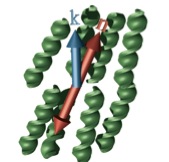Liquid Crystalline Soft Matter
Chirality
The adjective chiral is used for objects that lack mirror symmetry. The most famous chiral object is the human hand as you can easily verify by looking at the image of your right hand in the mirror and comparing with your real left hand: they are the same. In contrast, if you try to wear a right-hand glove on your left hand it will not work, because the right and left hands are indeed different objects (the word chiral actually comes from the Greek word for hand). They are said to be enantiomers, or stereoenantiomers, of each other.
Numerous compounds playing important roles in our lives, such as sugar, DNA and many pharmaceuticals are chiral, meaning that the molecule exists in at least two forms, one that can be referred to as left-handed and another that is the mirror image of the first and can then be considered to be right-handed (many molecules have more than one points where mirror symmetry is broken and then more than two versions are possible). The lack of mirror symmetry can have immense consequences for the properties of the chiral compound and its interaction with surrounding matter, sometimes of academic importance only, but in other cases the consequences of the wrong enantiomer can be disastrous (as in some famous pharmaceuticals).
If a liquid crystal contains chiral molecules with one enantiomer being present at higher concentration than the other, the mirror symmetry is broken not only on the molecular scale but in fact on the macroscopic scale. The long-range order of the liquid crystal phase can amplify the chirality, for instance onto the helical superstructures that the liquid crystal may form in case of chiral nematic or chiral smectic-C-type phases. In the latter case the combination of lack of mirror symmetry with a layered molecule arrangement in which the molecules tilt away from the layer normal additionally leads to the appearance of a spontaneous polarization, and then the liquid crystal can be ferro- or antiferroelectric. Chirality thus renders the whole liquid crystal phase chiral, a phenomenon that is highlighted by adding a star to the phase short-hand in case of chiral liquid crystals, thus N*, SmA*, SmC* etc.
Chiral liquid crystals play important roles in our research, both as self-assembled and responsive photonic crystals of chiral nematic type, giving for instance electrospun polymer fibers new functionality, and as very fast switching electrooptic materials that may find use in next generation liquid crystal displays.
 Back to research overview map.
Back to research overview map.
